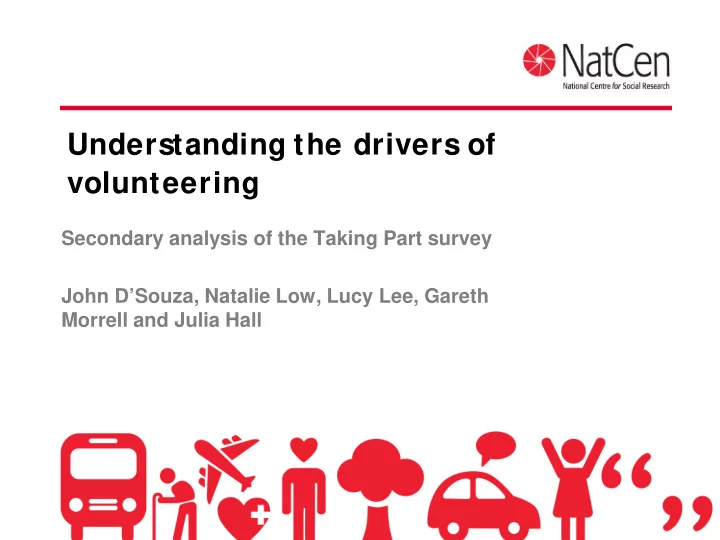

Understanding the drivers of volunteering Secondary analysis of the Taking Part survey John D’Souza, Natalie Low, Lucy Lee, Gareth Morrell and Julia Hall
Background
The wider context • Policy agenda volunteering a key pillar of the ‘Big Society’ • • The evidence Citizenship Survey shows a steady decline in volunteering • since 2005 • Economic climate increasingly challenging for voluntary sector •
About the study • Brief literature review What are the trends and patterns in volunteering • • Secondary analysis of Taking Part Survey Identify key drivers of volunteering, focusing on sports, arts, • heritage, and MLA sectors Developing a typology of individuals who do volunteer •
What do we know? Who volunteers Drivers Sports Tend to be younger and Family – ‘Stalwarts’ aiming to improve male child’s experience of participation Highest in 35-44, link Professional development – those with an with families interest in a career in sport Arts and MLA Tend to be older and Context specific – sector interest, female (except ‘specialists’ museums) Roles – less formalised attracts particular Limited ethnic diversity type of volunteer Environment Tend to be older, Context specific – sector interest, geographically attachment to place and heritage clustered Responsibility – improve environmental Limited ethnic diversity awareness, make use of skills
Drivers of volunteering
Methodology • Logistic Regression • Volunteering across the sports, arts, heritage, and museums, libraries and archives (MLA) sectors • 2007/08 and 2008/09 waves of TP
Variables • Demographics Age, gender, ethnicity, marital status, structure of household, • tenure, religion • Health and lifestyle General health, LT illness, smoking status, drinking • • Social stratification NSSEC, employment status, highest qualification, ACORN, car • and internet access
Results – overall volunteering • Demographics men, younger age groups, those of white ethnicity • • Health and lifestyle those with good health, a non-limiting illness, non-smoking, • drink alcohol • Social stratification higher NSSEC classification, academic qualifications, less • deprived ACORN areas, car and internet access
Sector specific – sports volunteering • Drivers very similar to drivers of overall volunteering • Differences Children, owns home • Ethnicity not a driver • • Good health main driver
Sector specific – arts volunteering • Similarities Academic qualifications, advantaged (ACORN, NSSEC), good • health, non-limiting LT illness, drinks alcohol • Differences Older, women, single, work part-time or not working • Ethnicity and smoking status not drivers • • Academic qualifications main driver
Sector specific – heritage volunteering • Similarities Higher education, advantaged (ACORN), drinks alcohol • • Differences Older, single, work part-time or not working • Ethnicity, gender, health and smoking status not drivers • • Higher education main driver
Sector specific – MLA volunteering • Not many drivers identified • Similarities Academic qualifications, internet access • • Differences Older, work part-time or not working • Ethnicity, gender, health, smoking status and drinking alcohol • not drivers • Academic qualifications main driver
Patterns of volunteering
Methodology • Latent Class Analysis (LCA) • Variables used – sector of volunteering activities, tasks involved in volunteering activities • Included “any other sector” volunteers
Results – groups found 7% 12% General Sports-focussed 14% Multi-activity Arts and heritage 67%
General volunteers • Two thirds of volunteers in the TP sample • “any other sector” volunteers • Fundraising, organising and running events, other practical help • Majority mentioned only 1 task as part of their volunteer work • Predominantly female • Older on average than other volunteer groups
Sports-focussed volunteers • 14% of volunteers in the TP sample • Sports sector volunteers • Coaching or tuition, fundraising, organising or running activities • Majority mentioned only 1 task • Predominantly male • More likely to: be younger, have children • More likely than other groups to have participated in sports • More likely to agree that they had some influence over the quality and variety of local sporting facilities
Multi-activity volunteers • 12% of volunteers in the TP sample • Carried out multitude of different activities • 95% undertook 5 or more tasks • 31% volunteered in 2 or more sectors • More likely than other groups to: be in middle age range, be married or cohabiting, have higher education, have professional/managerial NSSEC classification • High levels of participation in arts and heritage events • The group most likely to: Agree they had some influence over the quality of their local • environment and local cultural facilities Have visited libraries, museums and art galleries, and historic sites • when growing up
Arts and heritage volunteers • 7% of volunteers in the TP sample • 59% of this group volunteered in arts sector, 35% in heritage, and 4% in both • More likely than other groups to volunteer in the museums/galleries sector and libraries sector • 40% were involved in organising or helping to run an event • More likely to: be single, be without children, live in London • High levels of participation in arts and heritage events • Also likely to agree that they were able to influence local cultural facilities
Summary
Summary of findings • Drivers Distinct demographic profile for each sector • Many of the drivers of volunteering are similar to the drivers of • participation in these sectors • Patterns 4 distinct groups • Distinct sports group – influence over quality and variety of • local sporting facilities Multi-activity and arts and heritage groups – influence over • local cultural facilities
Thank you
Recommend
More recommend